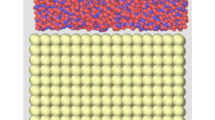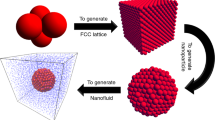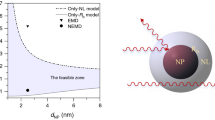Abstract
Nanofluids formed by adding a small volume fraction of solid nanoparticles to the conventional fluid can greatly enhance the thermal transport performance of the conventional fluid. This study reveals the mechanism of thermal conductivity by studying the microscopic effect of nanoparticles in a Cu–Ar nanofluid on the base fluid. Due to the presence of a trapped, adsorbed Ar layer on the surface of the nanoparticle, under certain volume fractions, the influence of the nanoparticles with different sizes on the thermal conductivity is analyzed. The equilibrium molecular dynamics and nonequilibrium molecular dynamics methods are used to calculate and verify the thermal conductivity of the nanofluid, and the abilities of the Lennard–Jones (LJ) and embedded atom method (EAM) potential functions to accurately describe interactions between Cu atoms are compared. By calculating the contribution of different components to the thermal conductivity of the nanofluid, it is found that the composition of the base liquid plays a leading role, while the nanoparticle composition and the solid–liquid cross-section contribute very little. Through decomposition of the Green–Kubo formula (contains potential energy term (V), the kinetic energy term (K), the collision term (V)), it is found that the PV, KV, and VV terms are related to collisions (V) when the LJ potential function is used, which play a major role in the nanofluid’s thermal conductivity. Partial enthalpy terms h, PP, and KK contribute little to the thermal conductivity, and they hinder any decrease of the thermal conductivity as the size of the nanoparticles increases; meanwhile, the KP term remains basically constant. In systems described by the EAM potential function, the contributions of KP and PP are relatively high. Therefore, this paper analyzes the mechanism of increasing the thermal conductivity of Ar-based nanofluid from the perspective of molecular dynamics simulation and obtains the results.



















Similar content being viewed by others
Reference
S.U.S. Choi, Enhancing Thermal Conductivity of Fluids with Nanoparticles (Energy Technology Division, Argonne National Laboratory, USA, 1995)
J.A. Eastman, S.U.S. Choi, S. Li et al., Anomalously increased effective thermal conductivities of ethylene glycol-based nanofluids containing copper nanoparticles. Appl. Phys. Lett. 78, 718 (2001)
Eastman, J.A., Choi, U.S., Li, S., et al. Enhanced thermal conductivity through the development of nanofluids. MRS Online Proc. Library Arch. 1996:3.
G.P. Peterson, C.H. Li, Heat and mass transfer in fluids with nanoparticle suspensions. Adv. Heat Transfer 39, 257–376 (2006)
C.H. Li, G.P. Peterson, Development in the effective thermal conductivity research of nanoparticle suspensions (nanofluids). (Nova Science Publishers, 2008), pp. 243 − 275.
J. Eapen, J. Li, S. Yip, Mechanism of thermal transport in dilute nanocolloids. Phys. Rev. Lett. 98(2), 028–302 (2007)
P. Keblinski, S. Phillpot, S.U. Choi, J. Eastman, Mechanisms of heat flow in suspensions of nano-sized particles (nanofluids). Int. J. Heat Mass Transfer 45, 855–863 (2002)
J.M. Haile, Molecular Dynamics Simulation: Elementary Methods. Library of Congress Cataloging in Publication Data (Wiley, New York, 1997).
S. Thomas, C.B. Sobhan, G.P. Peterson. Synthesis of Stable Nanoparticle Suspensions for Thermal Engineering Applications Advances and Challenges. Nanotechnology, Vol. 2: Synthesis and Characterization (2013).
M.J. Javanmardi, K. Jafarpur, A molecular dynamics simulation for thermal conductivity evaluation of carbon nanotube-water Nanofluids. J. Heat Transfer 135(4), 042401 (2013)
L. Li, Y. Zhang, H. Ma et al., An investigation of molecular layering at the liquid-solid interface in nanofluids by molecular dynamics simulation. Phys. Lett. A 372(25), 4541–4544 (2008)
L. Ling, Y. Zhang, H. Ma et al., Molecular dynamics simulation of effect of liquid layering around the nanoparticle on the enhanced thermal conductivity of nanofluids. J. Nanopart. Res. 12(3), 811–821 (2010)
H. Kang, Y. Zhang, M. Yang, Molecular dynamics simulation of thermal conductivity of Cu–Ar nanofluid using EAM potential for Cu–Cu interactions. Appl. Phys. A 103(4), 1001–1008 (2011)
J. Paul, A.K. Madhu, U.B. Javadeep, et al. Liquid layering and the enhanced thermal conductivity of Ar-Cu nanofluids: a molecular dynamics study, in Heat Transfer Summer Conference, ASME, 2016.
L. Xue, P. Keblinski, S.R. Phillpot et al., Effect of liquid layering at the liquid–solid interface on thermal transport. Int. J. Heat Mass Transfer 47(19–20), 4277–4284 (2004)
J. Paul, A.K. Madhu, U.B. Javadeep et al., A molecular dynamics study of liquid layering and thermal conductivity enhancement in nanoparticle suspensions. Heat Mass Transfer 54(3), 785–791 (2018)
X. Wang, D. Jing, Molecular dynamics study of contribution of the particle surface absorption layer to the thermal conductivity of nanofluids. J. Eng. Thermophys. 38(7), 1459–1465 (2017)
J. Chen, S.H.I. Lin, A.N. Qingsong, Using molecular dynamics to simulate the effective thermal conductivity of nanofluids. J. Tsinghua Univ. 12, 1983–1987 (2010)
R.P. Selvam, S. Sarkar, Equilibrium molecular dynamics simulation study on the effect of nanoparticle loading and size on thermal conductivity of nanofluids. 2007 ASME-JSME Thermal Engineering Summer Heat Transfer Conference, Vancouver, Canada, 2007, Paper No. HT2007-32314.
J. Liu, W.Q. Lu, Molecular dynamics simulation of the thermal conductivity of Ar-Al nanofluid using simplified model. in ASME 2009 2nd Microl Vanoscale Heat and Mass Transfer International Conference, Shanghai, China, 2009, Paper No. MNHMT2009-18275.
Cui Wenzheng, Bai Minli, Lv Jizu et al., Basic research on enhancing mechanisms of heat conduction of nanofluids for its application in cooling water jacket of IC engine. Trans. CSICE 6(31), 31–088 (2013)
Hongbo Guo, Ningbo Zhao, Interfacial layer simulation and effect on Cu-Ar nanofluids thermal conductivity using molecular dynamics method. J. Mol. Liquids 259, 40–47 (2018)
X. Wang, D. Jing, Determination of thermal conductivity of interfacial layer in nanofluids by equilibrium molecular dynamics simulation. Int. J. Heat Mass Transfer 218, 199–207 (2019)
Saeed Tareq, Abbas Ibrahim, Marin Marin, A GL model on thermo-elastic interaction in a poroelastic material using finite element method. Symmetry 2020(12), 488 (2020). https://doi.org/10.3390/sym12030488
A.I.A. Marin, Analytical solution of thermoelastic interaction in a half-space by pulsed laser heating. Physica E 87, 254–260 (2017)
G. Palani, I.A. Abbas, Free convection MHD flow with thermal radiation from an impulsively started vertical plate. Nonlinear Anal. 14(1), 73–84 (2009)
Ibrahim Abbas, Natural frequencies of a poroelastic hollow cylinder. Acta Mech. 186(1-4), 229–237 (2006)
Abo-El-Nour N. Abd-Alla, Ibrahim Abbas, A problem of generalized magnetothermoelasticity for an infinitely long, perfectly conducting cylinder. J. Thermal Stress. 25(11), 1009–1025 (2002)
R. Kumar, I.A. Abbas, Deformation due to thermal source in micropolar thermoelastic media with thermal and conductive temperatures. J. Comput. Theoret. Nanosci 10(9), 2241–2247 (2013)
Ibrahim A. Abbas, Marin Marin, Analytical solutions of a two-dimensional generalized thermoelastic diffusions problem due to laser pulse. Iran. J. Sci. Technol. 42(1), 57–71 (2018)
J. Chen, S. Lin, A. Qingsong, Effective thermal conductivity of nanofluid from molecular dynamics simulations. J. Tsinghua Univ. (Sci&Tech) 50(12), 1983–1987 (2010)
A. Loya, J.L. Stair, G. Ren, The study of simulating metaloxide nanoparticles in aqueous fluid. Int. J. Eng. Res. Technol. 4, 1954–1960 (2014)
Adil Loya, Guogang Ren, Molecular dynamics simulation study of rheological propertiesof CuO–water nanofluid. J. Mater. Sci. 50, 4075–4082 (2015)
W. Cui, Z. Shen, J. Yang et al., Molecular dynamics simulation on the microstructure of absorption layer at the liquid–solid interface in nanofluids. Int. Commun. Heat Mass Transfer 71, 75–85 (2016)
F. Cheng, Molecular Dynamics Simulation of Transport Characteristics of Nanofluids. Dalian University of Technology, 2016.
S.L. Lee, R. Saidur, M.F.M. Sabri et al., Molecular dynamic simulation: Studying the effects of Brownian motion and induced micro-convection in nanofluids. Numer. Heat Transfer Part A 69, 643–658 (2015)
Z.M. Zheng, B. Wang, A prediction model for the effective thermal conductivity of nanofluids considering agglomeration and the radial distribution function of nanoparticles. Acta Mech. Sin. 34, 507–514 (2018)
R. Essajai, A. Mzerd, N. Hassanain et al., Thermal conductivity enhancement of nanofluids composed of rod-shaped gold nanoparticles: insights from molecular dynamics. J. Mol. Liq. (2019). https://doi.org/10.1016/j.molliq.2019.111494
J. Chen, K. Han, S. Wang, Investigation of enhanced thermal properties of Cu-Ar nanofluids by reverse non-equilibrium molecular dynamics method. Powder Technol. 356, 559–565 (2019)
B. Usowicz, J.B. Usowicz, L.B. Usowicz, Physical-statistical model of thermal conductivity of nanofluids. J. Nanomater. (2014). https://doi.org/10.1155/2014/756765
S. Plimpton, Fast parallel algorithms for short-range molecular dynamics. J. Comp. Phys. 117, 1–19 (1995)
W. Humphrey, A. Dalke, K. Schulten, VMD: visual molecular dynamics. J. Mol. Graph. 14(1), 33–38 (1996)
W. Cui, Mechanism of momentum and heat transfer enhancement in nanofluids by molecular dynamics simulation. Dalian University of Technology, 2012.
Z. Chen, X.U. Weiren, L. Tang, in The Theory and Basis of Molecular Simulation, ed. by Y. Chen, X. Sun, 1st edn. (Chemical Industry Press, Beijing, 2007).
J.G. Lee, Computational Materials Science an Introduction, 2nd edn. (CRC Press, Taylor & Francis, Boca Raton, 2017)
S.M. Foiles, M.I. Baskes, M.S. Daw, Embedded-atom-method functions for the fcc metals Cu, Ag, Au, Ni, Pd, Pt, and their alloys. Phys. Rev. B 12, 7983–7991 (1986)
W. Cui, Z. Shen, J. Yang et al., Molecular dynamics simulation on the microstructure of absorption layer at the liquid solid interface in nanofluids. Int. Commun. Heat Mass 71, 75–85 (2015)
Chen Guangqi, Chen Shuping, Chang Kun et al., Study of heat transfer of finned tube heat exchanger for cryogenic liquids. Vacuum Cryogenics 4, 1006–7068 (2007)
M.P. Allen, D.J. Tildesley, Computer Simulation of Liquids (Clarendon Press, Oxford, 1987)
H.J.M. Hanley, Transport Phenomena in Fluids (Marcel Dekker, New York, 1969)
P. Sindzingre, C. Massobrio, G. Ciccotti, D. Frenkel, Calculation of partial enthalpies of an argon-krypton mixture by NPT molecular dynamics. Chem. Phys. 129, 213–224 (1989)
T. Ikeshoji, B. Hafskjold, Non-equilibrium molecular dynamics calculation of heat conduction in liquid and through liquid-gas interface. Mol. Phys. 81, 251 (1994)
S. Sarkar, R. Panneer, Molecular dynamics simulation of effective thermal conductivity and study of enhanced thermal transport mechanism in nanofluids. J. Appl. Phys 102(10), 074302 (2007)
F. Muller-Plathe, A simple nonequilibrium molecular-dynamics method for calculation the thermal-conductivity. J. Chem. Phys. 106(14), 6082 (1997)
M.O. Mclinden, S.A. Klein, E.W. Lemmon, et al., NIST Thermodynamic Properties of Refrigerants and Refrigerants Mixtures Database (REFPROP). NIST Ste Ref Database23, Version 7.01, 2006.
Wang Buxuan, Zhou Pingle, Peng Xiaofeng, Fractal model of effective thermal conductivity of nanoparticle suspension. Progress Nat. Sci. 9, 838–842 (2003)
W. Yu, S.U.S. Choi, The role of interfacial layers in the enhanced thermal conductivity of nanofluid: a renovated Maxwell model. J. Nanopart. Res. 5, 167–171 (2003)
Huaqing Xie, Motoo Fujii, Xing Zhang, Effect of interfacial nanolayer on the effective thermal conductivity of nanoparticle-fluid mixture. Int. J. Heat Mass Transfer 48(14), 2926–9310 (2005)
Acknowledgement
This research was supported by the Hebei Provincial Education Department fund of China (Grant No. ZD2020169).
Author information
Authors and Affiliations
Corresponding author
Additional information
Publisher's Note
Springer Nature remains neutral with regard to jurisdictional claims in published maps and institutional affiliations.
Rights and permissions
About this article
Cite this article
Zhang, L., Tian, L., Zhang, A. et al. Molecular Dynamics Simulations of the Effects of a Nanoparticle Surface Adsorption Layer on the Thermal Conductivity of a Cu–Ar Nanofluid. Int J Thermophys 42, 44 (2021). https://doi.org/10.1007/s10765-021-02794-0
Received:
Accepted:
Published:
DOI: https://doi.org/10.1007/s10765-021-02794-0




